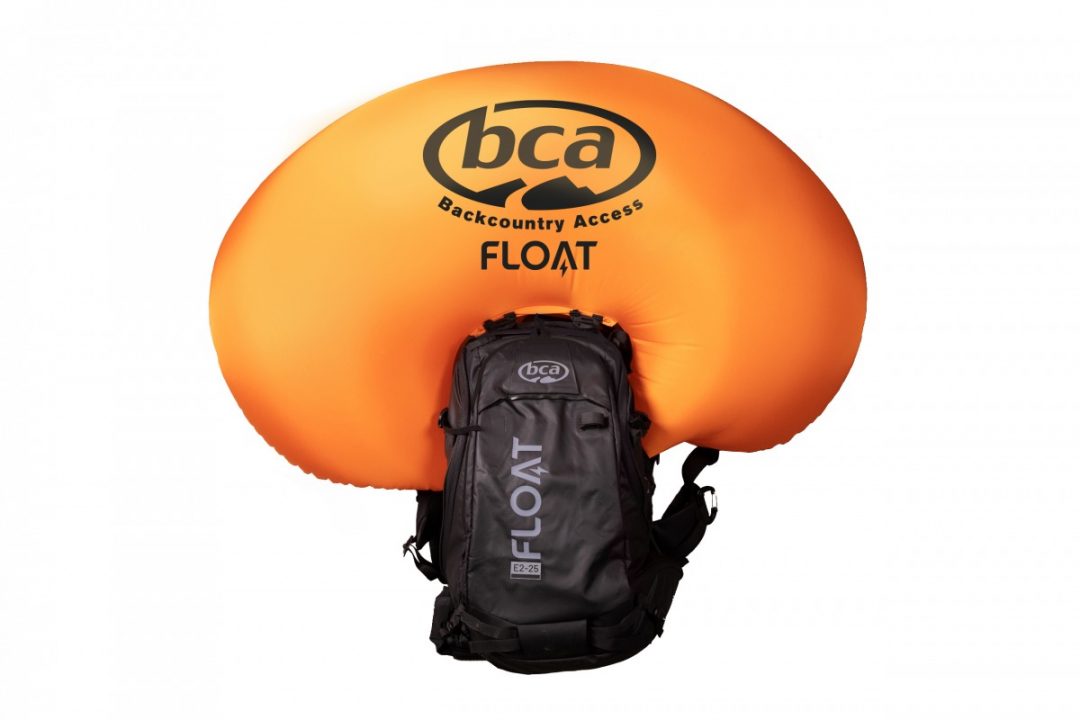
BCA’s FLOAT E2 25 will be released next fall. This robust pack comes built for hard knocks and integrates Alpride’s new E2 electronic airbag system into the build.
In this episode of the airbag chronicles, we’re looking at the BCA FLOAT E2 25 backpack. For length, as this became way too long, expect two pieces on the pack, one focusing on the pack (and a small bit about the E2 system), the second taking a deeper dive into the new Alpride E2 system integrated into the FLOAT E2 25.
The FLOAT E2 25 will be available for purchase next fall for $1299.95 in sizes S/M and M/L. The hottest topic about the pack is the utilization of Alpride’s newest electronic (meaning supercapacitor) system, the E2. Evidently, the E2 is 40% smaller than the E1 (not sure about that) and 140g lighter when weighing each system against the other. The E2 system is removable, however, it is not interchangeable with the E1 system.
— Lou has the Alpride E1 system (no backpack) weighing: 1270 grams (2.8 pounds).
—The Alpride E2 system weighs 1140g (without AA batteries, which weigh an additional 50g). If you’ve got an E1 system, you’re carrying around a spare ether-light race binding. Not a deal-breaker as the math comes out to a 130g difference. But what’s 130 paperclips anyhow?
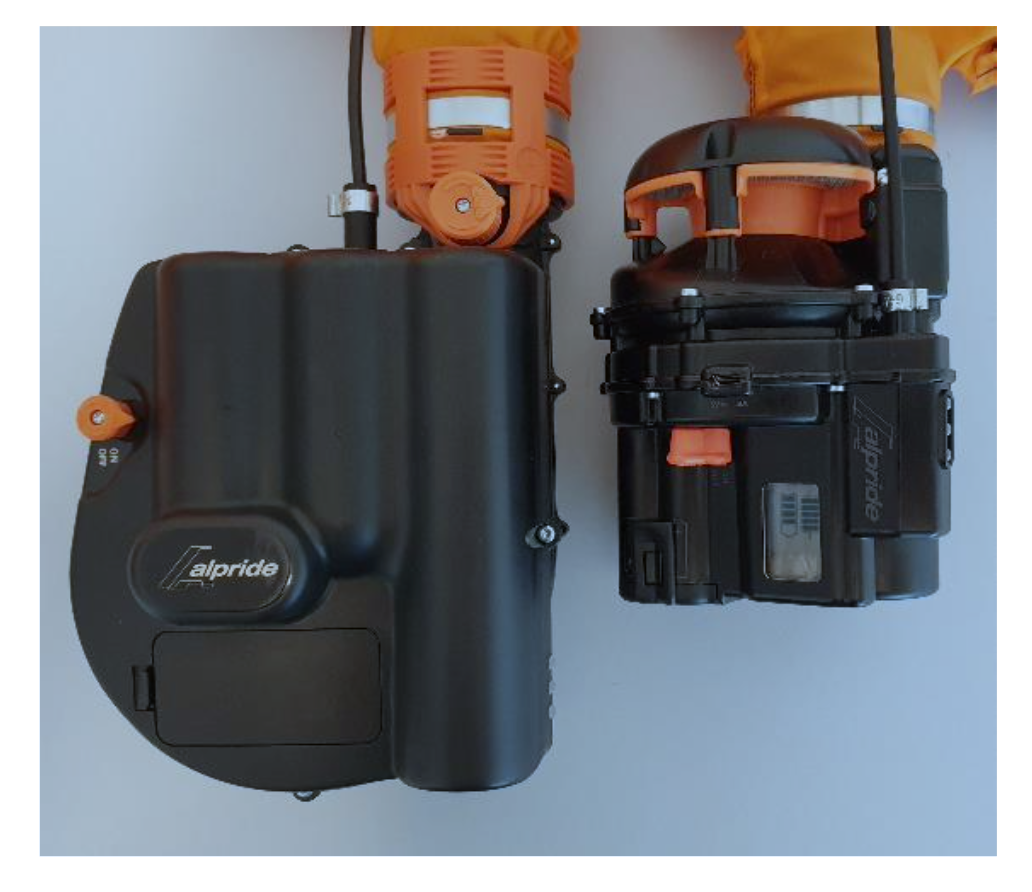
A side by side shot of the E1 system (left) and the smaller/lighter E2 system (right). Photo: Alpride.
With the E2 system installed in the FLOAT 25 E2, the system + backpack weight is 2790g (6.19 pounds) verified.
As we’ll state in all the airbag rundowns, you’ll carry more weight than a non-airbag style pack. If you covet these safety devices, there’s no getting around the increased cost and Newton’s Laws for the foreseeable future.
Looking at the data set provided by Ortovox, the total weight of the E2 system ranks as the sixth lightest; the ARVA system with a carbon-cartridge weighs 1000g and is the lightest. The Ortovox / Arc’Teryx Litric system, also an electric system, weighs 1100g, 40g less than the E2. I’ll have more on the E2 system in the next FLOAT E2 25 installment later this week.
On to the Pack
Examining the robust build of the FLOAT E2 25, you might be tempted to toss it at the end of the day in the back of a pickup. Don’t. And I say that not because electronic systems are fussy or cheaply assembled, but because there are electronics involved, it’s best to protect your investment of over $1000. Then again, there’s some irony in the thought above. The pack should thrive in the washing machine world of an avalanche. If looks are a determiner, bets are you’ll be in good hands with the FLOAT E2 25. Words that aptly describe the pack are sturdy, rugged, and strong.

An example of the FLOAT E2 25’s burly zippers and aluminum hardware.
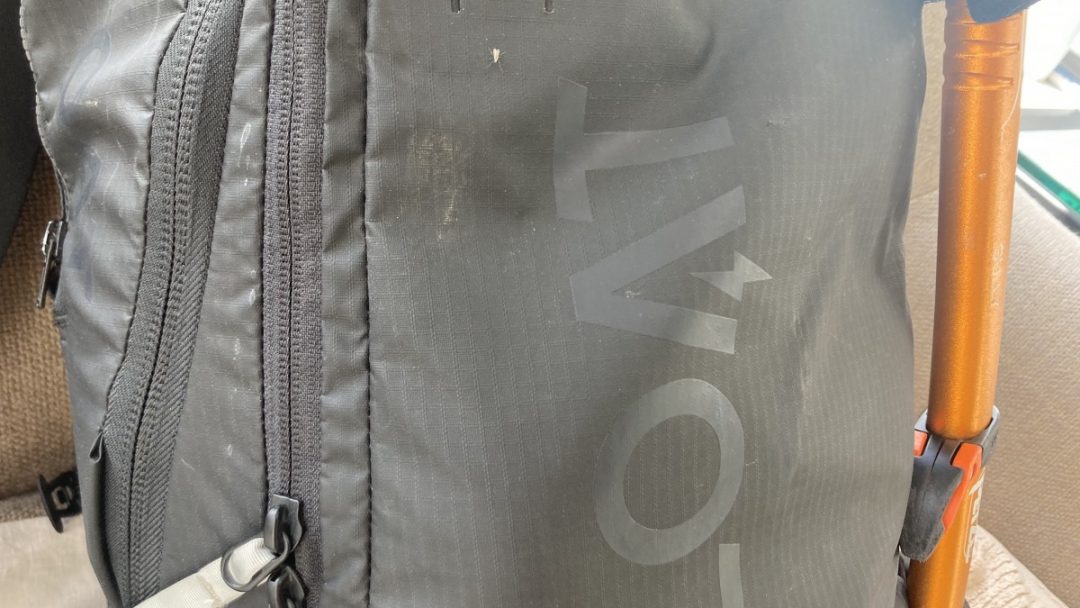
A close up of the FLOAT E2 25’s coated nylon fabric: think durable.
The zippers on the FLOAT 25 E2 are YKK (a good sign) and beefy. The fabric is a weather-resistant, durable coated nylon. The buckles and hardware securing the pack’s critical straps harnessing the bag to your body are aluminum. The sewing is impeccable. The leg loop, standard on all airbag packs, runs under and between the legs but fastens to a carabiner sewn and reinforced on the waistbelt. (This bypasses the usual system of securing the leg loop on the waistbelt buckle.) The carabiner is no toy; I’d trust it in a climbing fall.
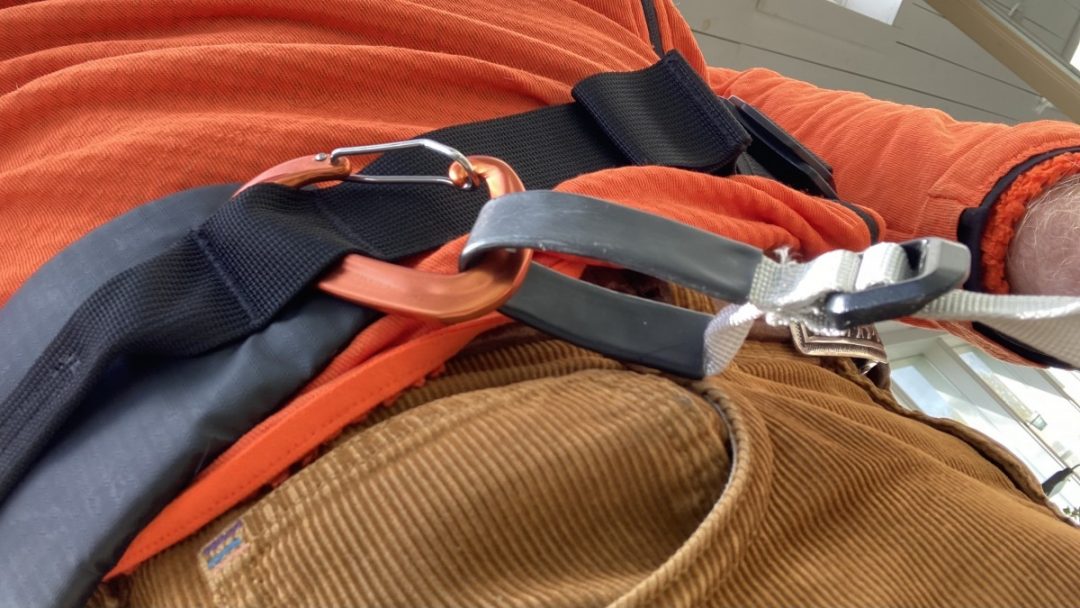
The FLOAT E2 25’s leg loop fastens to a carabiner secured to the waistbelt.
Guides spending 150 days+ in the field from fall to spring, I imagine this could be a reliable workhorse. But maybe opt for the FLOAT E2 35.
The feature set on the pack is the usual fare, with some upticks in design and function. First, this is early in the E2 system show; so when the option for a smaller volume 25 liter pack came up test out this spring, it was an obvious yes. With the E2 system installed, the pack trends towards a usable 25L. When packing, however, choose your spatial organization wisely– space is at a premium.
I’ve used the pack on a few warm days and during the cold snap, deeper snow days of, go figure, April. I can pack a windbreaker, puffy, big mittens, winter gloves, 1 L Nalgene and .5L soft flask, snacks, goggles, a vest, helmet, ski crampons, shovel, and probe. Pretty much the basics for a day out.
The Easily Stashed Goods

The fleece lined dedicated goggle pocket.
Goggles: the top of the pack can house a pair of goggles in a dedicated zippered fleece-lined pocket. No goggles; consider this another stash-anything-there pocket.

The helmet carry is stowable, and when it’s deployed, it’s secure.
Helmet Carry: BCA incorporates a stowaway helmet carry; it nests below the goggle pocket.
Main Compartment and Safety Tool Pocket
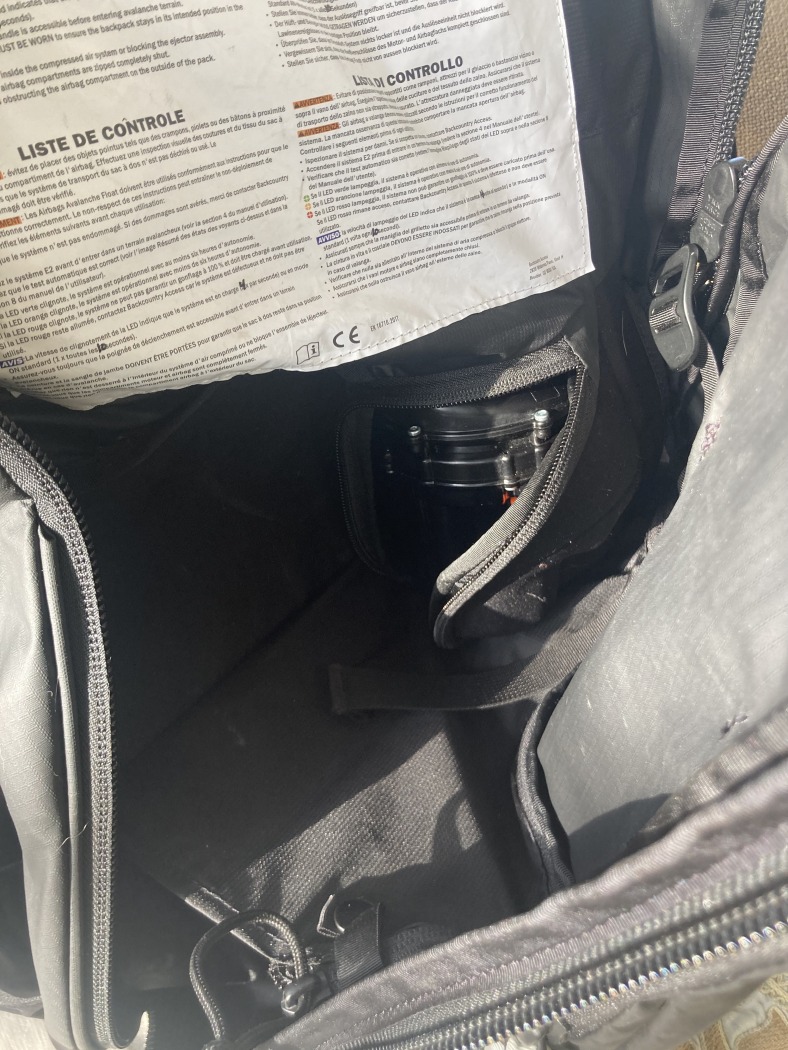
An empty main compartment includes an optional divider and a zip pocket for organizing smaller extras. The E2 supercapacitors, fan, and housing sit on the right side of the main compartment.
The main compartment has a basic clamshell zipper, with one side extending a bit further down than the other. This main compartment can be separated internally by a zip-away piece of sturdy nylon fabric. I often divide the main compartment into two parts for better organization. This area includes another zippered stash pocket for quick access to small essentials within the large void. (Note the photo; the fan and supercapacitors are housed towards the looker’s right side of the main compartment. If you space out the complexities of the E2 system, sewn into the main compartment is a helpful inspection checklist printed in multiple languages.)
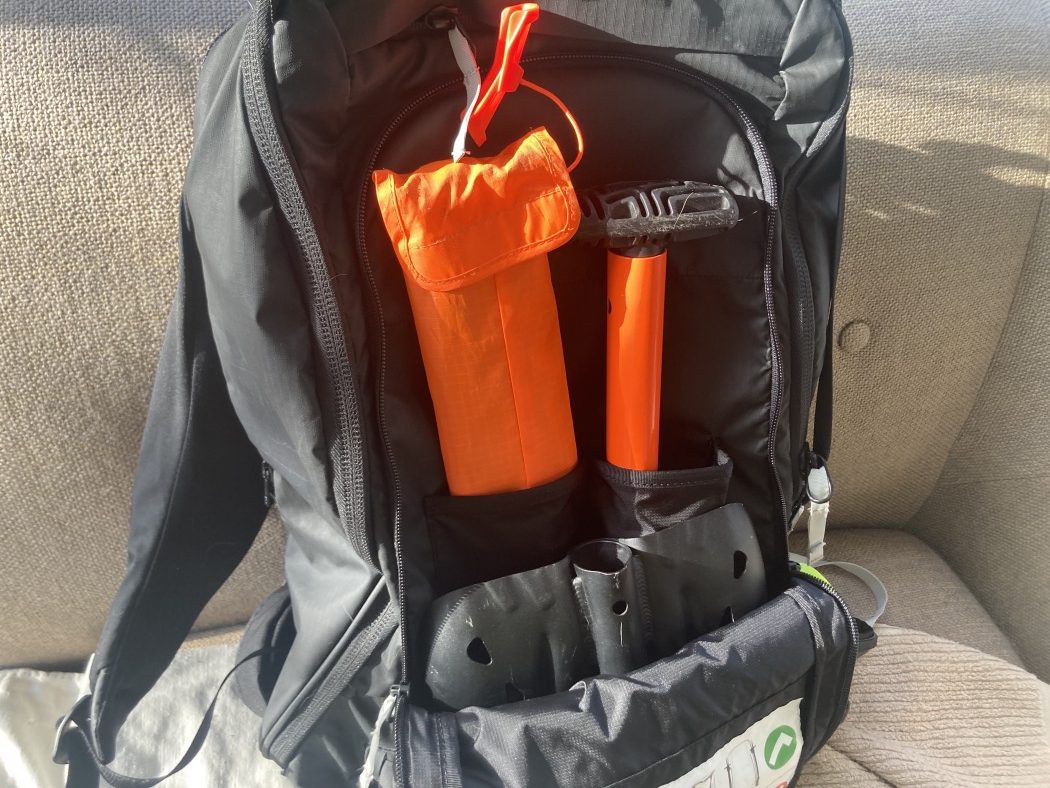
The safety pocket has ample room for the necessary items.
The FLOAT E2 25 possesses an ample external safety tool pocket with sleeves for a probe and shovel handle. My full-size shovel blade fit in with no issues. There’s also an additional zip-pocket big enough for skin wax, sunblock, and light liner gloves.
The Side Zip
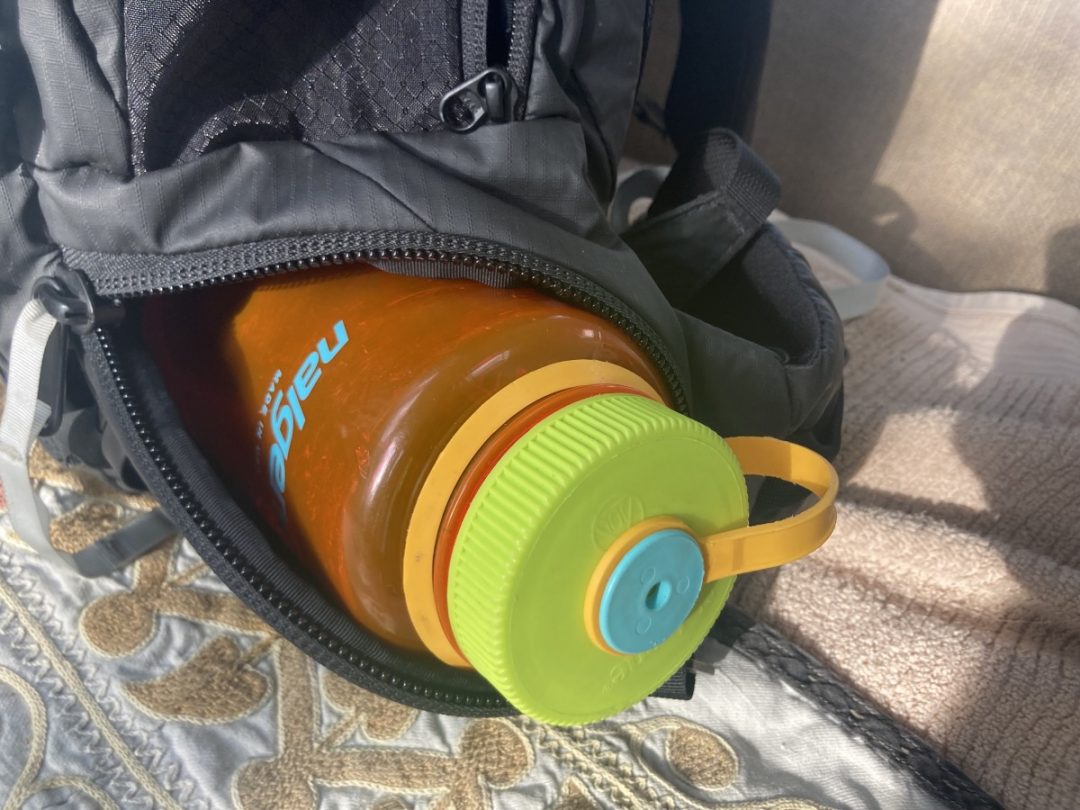
The side zip feature allows for on the fly access to water or stash skins for quick transitions.
The new FLOAT E2 packs have what BCA calls the “side zip” pocket. One accesses the “side zip” by tugging an easy-to-pull curved zipper near the right-hand side of the waistbelt. Without taking the pack off, one can access a Nalgene or skins to make transitions faster. The space, however, becomes tight with gear shoved in. I’ve found it tough to access both a 1L Nalgene and skins without removing the pack. Pick your preference, quick-grab water or skins, likely, not both. The “side zip” access is a handy, well-designed feature helping users stay organized and be more efficient.
Back Stash Zip
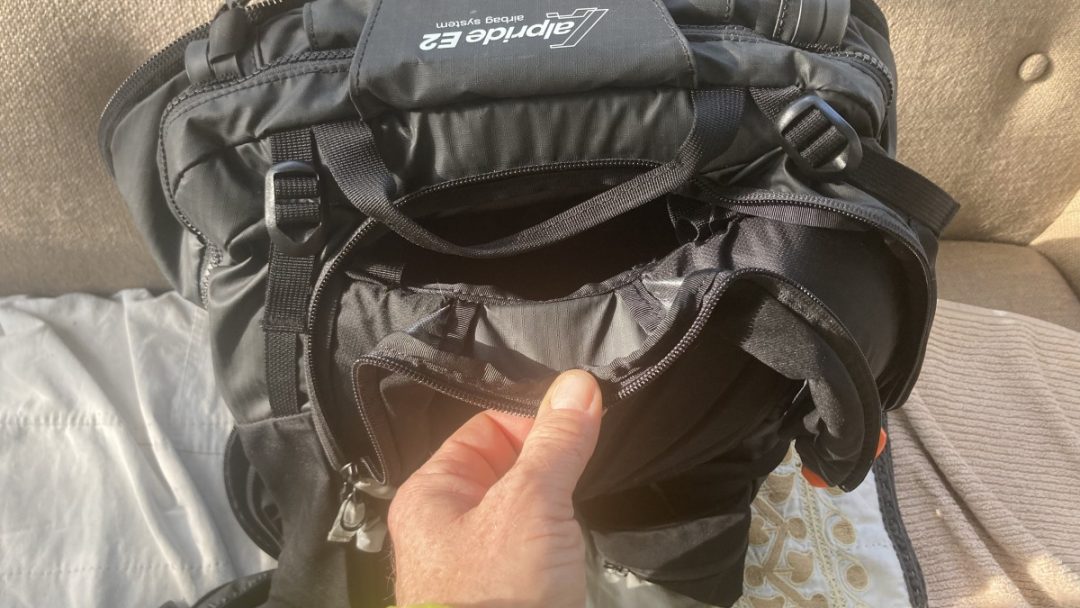
The back stash zippers opened up.
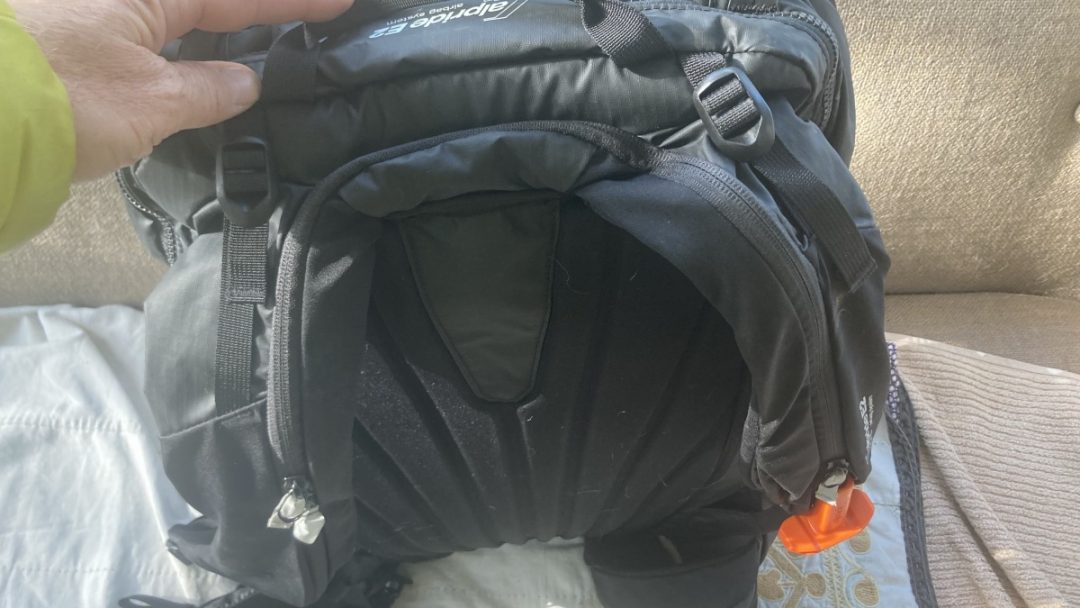
The back stash zips sealed up.
Most airbag packs are complex. So there’s more nuance to the FLOAT E2 25’s design. BCA incorporates a U-shaped multi-zipper system called the “back stash” on the shoulder straps to integrate hydration systems or routing items like BCA’s two-part radios. Most airbag packs have vertical zippers on both shoulder straps to route the trigger housing on either the left or right. The FLOAT E2s shoulder strap zippers make a complete U. Yes, you can route the pull trigger on either strap and adjust the trigger height. Also, at the top of the U, between the shoulder straps, one can access a hydration sleeve. Plop the hydration sleeve in the sleeve, route the tube into the non-trigger side shoulder strap, and zip it up. (The zippers can be adjusted to access the hydration tube and the bag’s trigger.) With the “back stash,” you can also seamlessly route the mic cord on a BCA radio into the non-trigger side shoulder strap. When zipped, the shoulder straps are sheathed in a slightly stretchy fabric. Zip it all up, and presto, you’ve got a clean-looking rig. There are four zippers on the “back stash” system, nothing too crazy as it is a two-way zip system. But if zippers are not your thing, particularly stout zippers that will likely last years, maybe look into some other design.
Wasitbelt
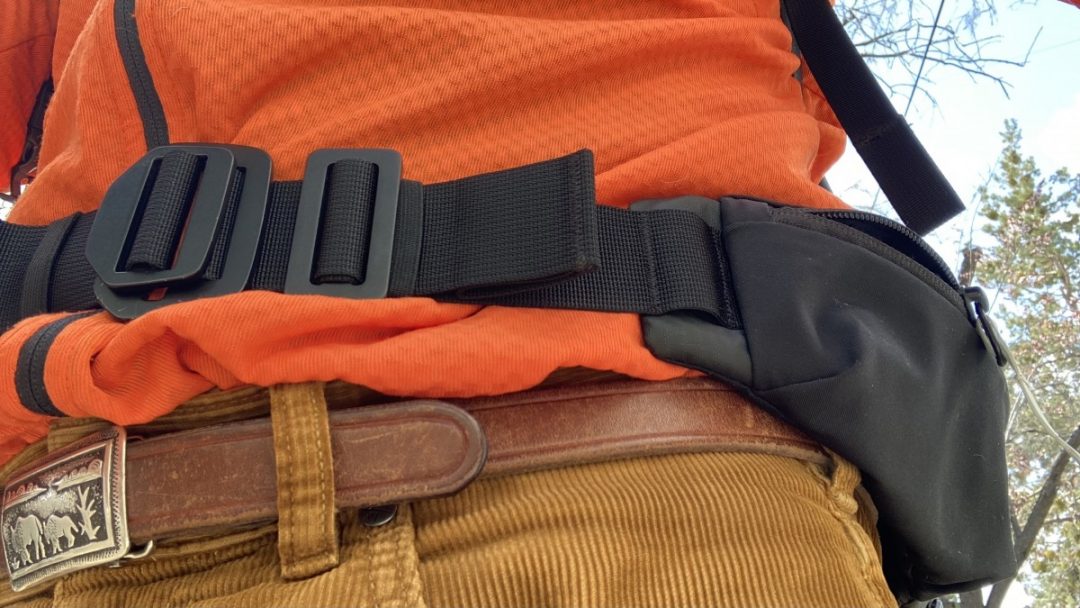
A shot of the padded waist belt and integrated pocket for quick hit snacks.
The padded waist belt also includes a zippered pocket for doo-dads on the left side, and a sewn gear loop on the right.
Axe Carry
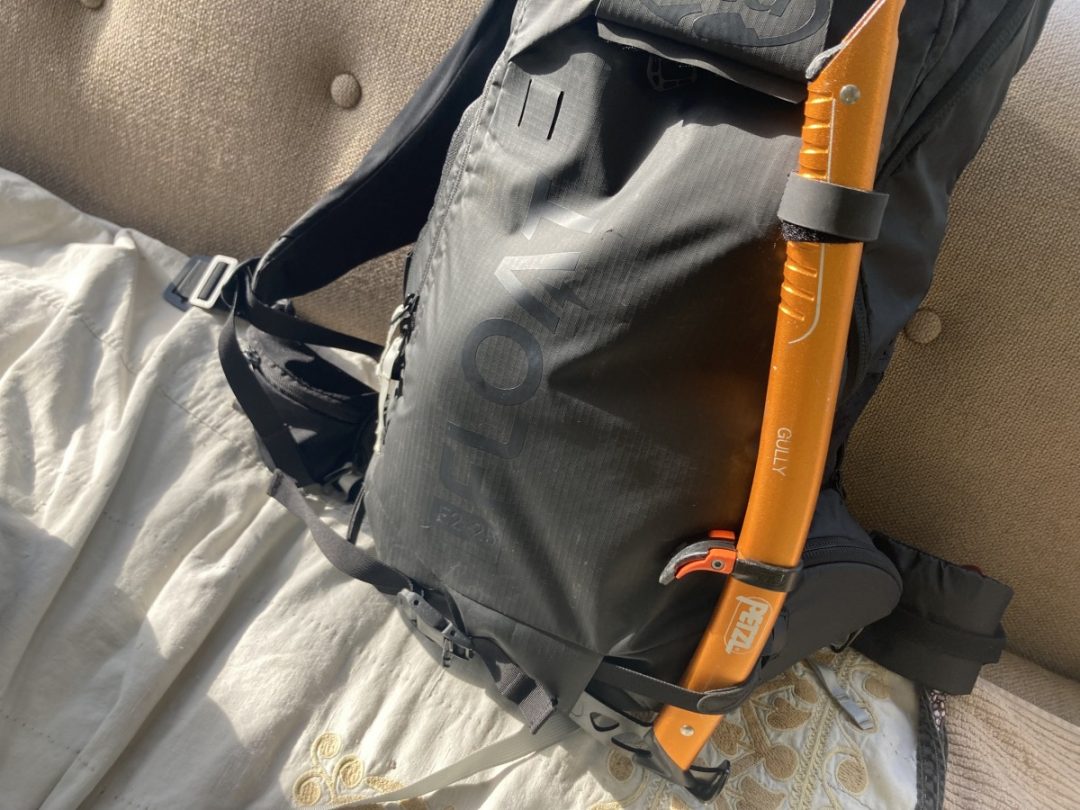
A simple axe carry system.
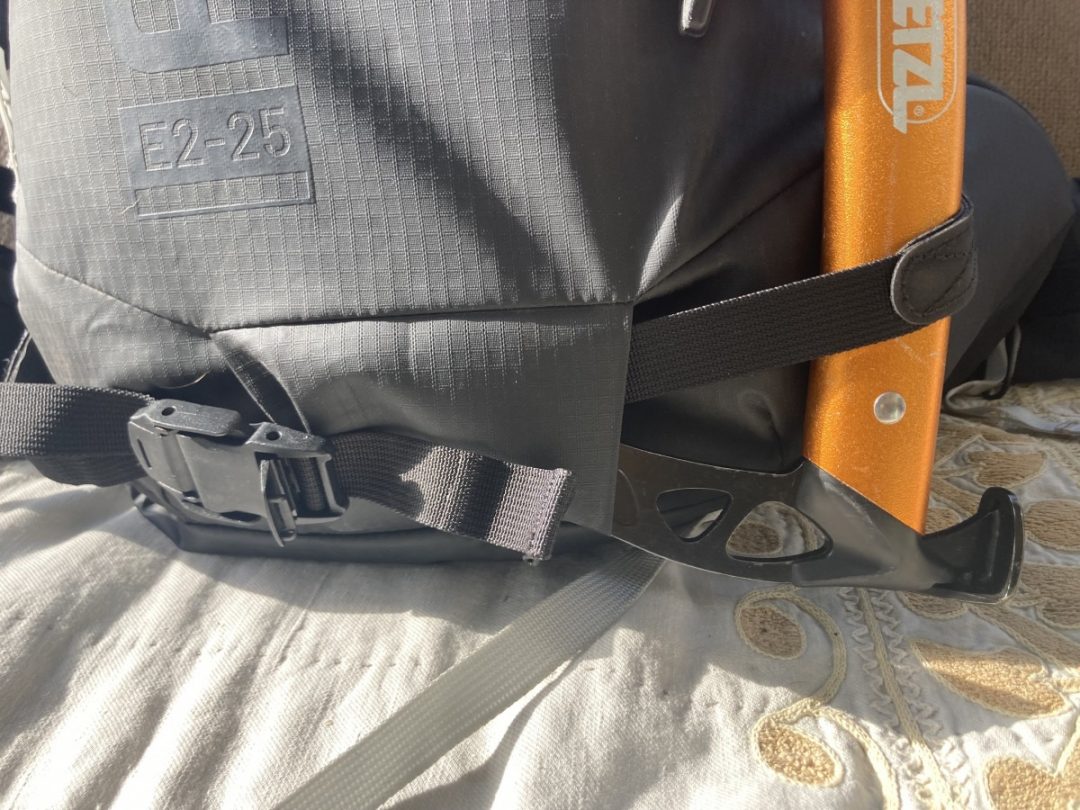
A close up of the axe carry system (pick/head part of axe).
For sportier skiers, the FLOAT 25 E2 can carry two axes. The shaft is affixed with a simple velcro tab, while the pick/head is secured in the same strap used to fasten ski tails for the diagonal carry. (You could carry a second axe, but this pack came with a single velcro closure for the shaft. The head of the second axe, if you were also carrying skis, would double as the lower half of the ski carry system.)
Ski Carry
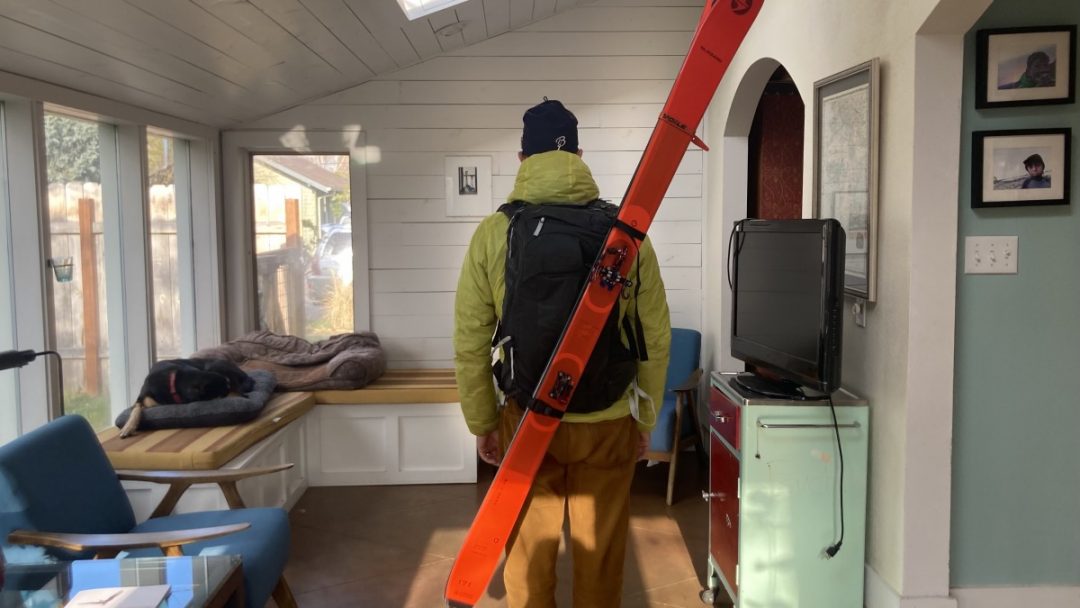
The diagonal ski carry case be set up with skis leaning to the right (show here) or left.
The pack can only carry skis diagonally; however, users can affix the system so skis can trend to the left or right. This pack cannot accommodate an A-frame carry.
Final Thoughts
For those who pack efficiently (I’ve seen you out in the hills lately), this pack, with its relatively small volume, might do it for you all winter long. It’s marketed not as a deep mission airbag pack, but for endeavors skewing closer to the trailhead or even the lifts. The BCA’s FLOAT E2 series will also be available in a 35-liter version next fall.
A few things I’d change. The interior of the pack’s main compartment, at least in this color model, is black. I prefer lighter-colored interiors; I perceive that I’m better able to locate items against a lighter background. This next detail was/is truly annoying. The chest strap is basic like it is with most packs. The chest strap’s height is adjusted by clipping each side to bartacked webbing that runs for several inches up and down each shoulder strap. I have the damnest time making the clip sit securely to the left shoulder strap. Maybe it’s super early in the test-production run and the barracks where I want to situate the clip on the left side are off by 2mm or 2.5mm. I know, a small detail on an otherwise supremely designed pack.
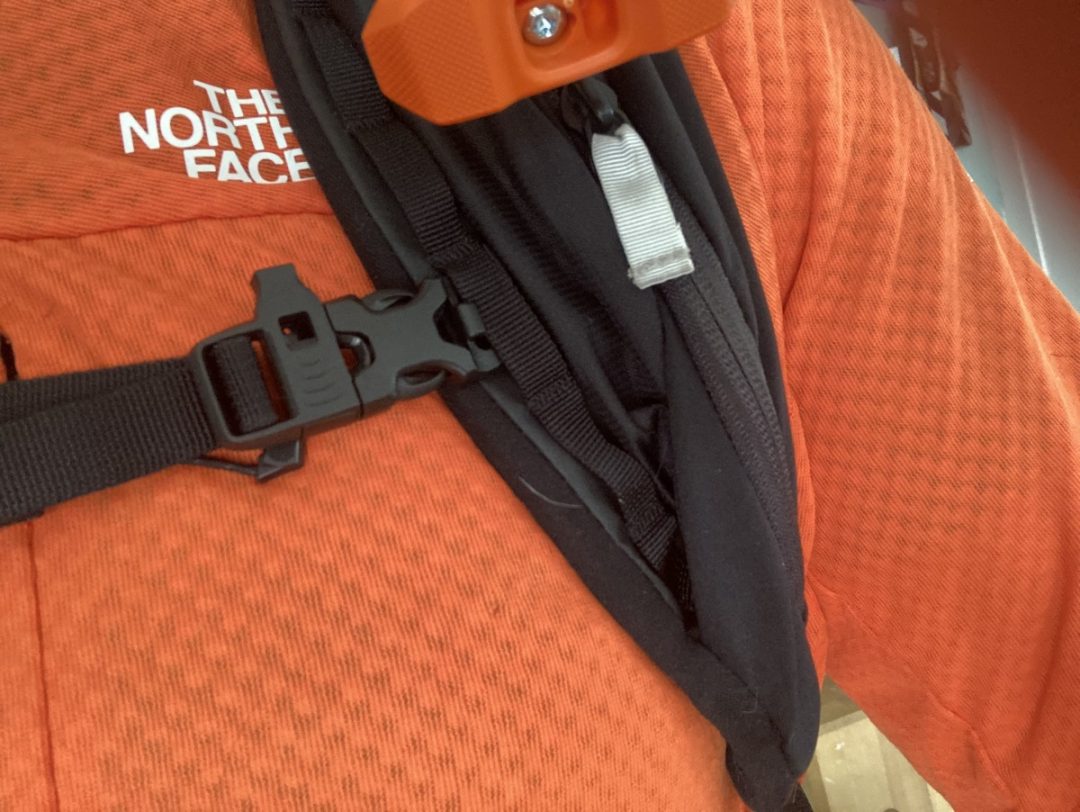
Uggh, the chest strap clip for the left shoulder strap is tough to make stay in place.
More importantly than maybe a small plastic clip, this pack carries great. The padded back panel, waistbelt, and shoulder straps, as well as the ability to micro-adjust the fit on the fly, make the FLOAT E2 25 easy to grab off the shelf for a day of touring and be comfortable hauling a load. Like any good pack, you want the fit to feel seamless when slogging up or focusing on the turns; the FLOAT E2 25 checks those boxes. As part of the daily safety device suite, you want an airbag pack to be something you want to wear. If the fit works, the feature set is to your liking and the useable volume aligns with your packing style, at least to me, this pack may be part of your pack quiver. Start saving.
Initially, the intent was to hammer it all out, exploring the pack and the E2 system in a single piece. I’m just beyond what I set as my word limit. Part two looks into the Alpride E2 system integrated into the FLOAT E2 25. I’ll have that write-up, “BCA’s FLOAT E2 25: The E2 Side of the Equation” posted on Friday.
Jason Albert comes to WildSnow from Bend, Oregon. After growing up on the East Coast, he migrated from Montana to Colorado and settled in Oregon. Simple pleasures are quiet and long days touring. His gray hair might stem from his first Grand Traverse in 2000 when rented leather boots and 210cm skis were not the speed weapons he had hoped for. Jason survived the transition from free-heel kool-aid drinker to faster and lighter (think AT), and safer, are better.
